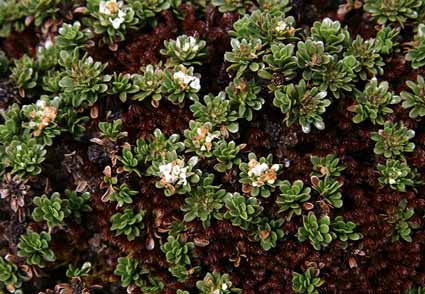Abstract
Three new species of Valeriana from southern Ecuador are described and illustrated. Valeriana plateadensis is found near the highest peak of Cerro Plateado in Cordillera del Cóndor at 2900 m a.s.l. and is recognized by the shrubby habit and sessile, densely imbricate, spatulate leaves and 3-lobed corollas. V. yacuriensis is found near Lagunas Negras de Jimbura in the Parque Nacional Yacurí at 3500 m a.s.l. and is recognized by the shrubby habit, petiolate leaves and 3-lobed corollas. V. xenophylloides is found in the Páramo de Patococha at 3400 m a.s.l. and is recognized by its cushion growth form, the crown of trichomes at the leaf apex and 3-lobed corollas.
References
<p align="justify"><span style="color: #000000;"><span style="font-family: Times New Roman, serif;"><span style="font-size: small;">Bell, C.D. (2004) Preliminary phylogeny of Valerianaceae (Dipsacales) inferred from nuclear and chloroplast DNA sequence data. <em>Molecular Phylogenetics and Evolution</em> 31 (1): 340–350. https://doi.org/10.1016/j.ympev.2003.07.006</span></span></span></p>
<p align="justify"><span style="color: #000000;"><span style="font-family: Times New Roman, serif;"><span style="font-size: small;">Bell, C.D. & Donoghue, M.J. (2005) Phylogeny and biogeography of Valerianaceae (Dipsacales) with special reference to the South American valerians. <em>Organisms Diversity & Evolution</em> 5 (2): 147–159. https://doi.org/10.1016/j.ode.2004.10.014</span></span></span></p>
<p align="justify"><span style="color: #000000;"><span style="font-family: Times New Roman, serif;"><span style="font-size: small;">Bittrich, V. & Kadereit, J.W. (2016) Introduction to the orders and families of uncertain placement of this volume. <em>In:</em> <em>Flowering Plants. Eudicots.</em> Springer, Cham, pp. 1–18. https://doi.org/10.1007/978-3-319-28534-4_1</span></span></span></p>
<p align="justify"><span style="color: #000000;"><span style="font-family: Times New Roman, serif;"><span style="font-size: small;">Candolle, A.P. de. (1830) <em>Prodromus systematis naturalis regni vegetabilis.</em> Vol. 4. Sumptibus Sociorum Treuttel et Würtz, Paris, pp. 624–642. </span></span></span></p>
<p align="justify"><span style="color: #000000;"><span style="font-family: Times New Roman, serif;"><span style="font-size: small;">Donoghue, M.J., Eriksson, T., Reeves, P.A. & Olmstead, R.G. (2001) Phylogeny and phylogenetic taxonomy of Dipsacales, with special reference to <em>Sinadoxa</em> and <em>Tetradoxa</em> (Adoxaceae). <em>Harvard Papers in Botany</em> 6: 459–479.</span></span></span></p>
<p align="justify"><span style="color: #000000;"><span style="font-family: Times New Roman, serif;"><span style="font-size: small;">Eriksen, B. (1989) Notes on generic and infrageneric delimitation in the Valerianaceae. <em>Nordic Journal of Botany</em> 9 (2): 179–187. https://doi.org/10.1111/j.1756-1051.1989.tb02113.x</span></span></span></p>
<p align="justify"><span style="color: #000000;"><span style="font-family: Times New Roman, serif;"><span style="font-size: small;">Eriksen, B. (1989) 186. Valerianaceae. <em>Flora of Ecuador</em> 34: 1–60.</span></span></span></p>
<p align="justify"><span style="color: #000000;"><span style="font-family: Times New Roman, serif;"><span style="font-size: small;">Fisher, A.E., Triplett, J.K., Ho, C., Schiller, A.D., Oltrogge, K.A., Schroder, E.S., Kelchner, S.A. & Clark, L.G. (2009) Paraphyly in the bamboo subtribe Chusqueinae (Poaceae: Bambusoideae) and a revised infrageneric classification for <em>Chusquea</em>. <em>Systematic Botany</em> 34 (4): 673–683. https://doi.org/10.1600/036364409790139790</span></span></span></p>
<p align="justify"><span style="color: #000000;"><span style="font-family: Times New Roman, serif;"><span style="font-size: small;">Graebner, P. (1906a) Valerianaceae andinae. <em>Botanische Jahrbücher für Systematik, Pflanzengeschichte und Pflanzengeographie </em>37: 436–451.</span></span></span></p>
<p align="justify"><span style="color: #000000;"><span style="font-family: Times New Roman, serif;"><span style="font-size: small;">Graebner, P. (1906b) Die Gattungen der natürlichen Familie der Valerianaceae. <em>Botanische Jahrbücher für Systematik, Pflanzengeschichte und Pflanzengeographie</em> 37: 464–480.</span></span></span></p>
<p align="justify"><span style="color: #000000;"><span style="font-family: Times New Roman, serif;"><span style="font-size: small;">IUCN (2022) <em>Guidelines for using the IUCN Red List categories and criteria. Version 15.1. </em>Prepared by the Standards and Petitions Committee. Available from: https://www.iucnredlist.org/resources/redlistguidelines (accessed 12 December 2022)</span></span></span></p>
<p align="justify"><span style="color: #000000;"><span style="font-family: Times New Roman, serif;"><span style="font-size: small;">Killip, E.P. (1928) Seven new species of <em>Valeriana</em>. <em>Journal of the Washington Academy of Sciences </em>18: 498–501.</span></span></span></p>
<p align="justify"><span style="color: #000000;"><span style="font-family: Times New Roman, serif;"><span style="font-size: small;">Kunth, K.S. (1819) <em>Nova Genera et Species Plantarum</em> (quarto ed.) 3: 324.</span></span></span></p>
<p align="justify"><span style="color: #000000;"><span style="font-family: Times New Roman, serif;"><span style="font-size: small;">Larsen, B.B. (1986) A taxonomic revision of <em>Phyllactis</em> and <em>Valeriana</em> sect. <em>Bracteata</em> (Valerianaceae). <em>Nordic Journal of Botany</em> 6 (4): 427–446. https://doi.org/10.1111/j.1756-1051.1986.tb00899.x</span></span></span></p>
<p align="justify"><span style="color: #000000;"><span style="font-family: Times New Roman, serif;"><span style="font-size: small;">Linnaeus, C. von (1753) <em>Species Plantarum</em> 1. Stockholm.</span></span></span></p>
<p align="justify"><span style="color: #000000;"><span style="font-family: Times New Roman, serif;"><span style="font-size: small;">Persoon, C.H. (1805) <em>Synopsis Plantarum: seu Enchiridium botanicum, complectens enumerationem systematicam specierum hucusque cognitarum</em>. apud CF Cramerum. https://doi.org/10.5962/bhl.title.638</span></span></span></p>
<p align="justify"><span style="color: #000000;"><span style="font-family: Times New Roman, serif;"><span style="font-size: small;">Rabuske-Silva, C. & Külkamp, J. (2018) <em>Valeriana iganciana</em> (Valerianaceae), a new species from the highland grasslands of Serra do Tabuleiro, Santa Catarina, Brazil. <em>Phytotaxa </em>364 (3): 275–282. https://doi.org/10.11646/phytotaxa.364.3.7</span></span></span></p>
<p align="justify"><span style="color: #000000;"><span style="font-family: Times New Roman, serif;"><span style="font-size: small;">Rabuske-Silva, C., Sobral, M. & Vieira Iganci, J.R. (2020) <em>Valeriana caparaoensis</em> (Valerianaceae <em>nom. conserv.</em>)<em>,</em> a new species from southeastern Brazil. <em>Systematic Botany</em> 45 (1): 219–225. https://doi.org/10.1600/036364420X15801369352496</span></span></span></p>
<p align="justify"><span style="color: #000000;"><span style="font-family: Times New Roman, serif;"><span style="font-size: small;">Silva, T.R.S. & Correa A., M.D. (2002)<em> Drosera peruensis </em>(Droseraceae), a new species from Peru. <em>Novon</em>, <em>A Journal for Botanical Nomenclature</em> 12 (4): 543–545. https://doi.org/10.2307/3393136</span></span></span></p>
<p align="justify"><span style="color: #000000;"><span style="font-family: Times New Roman, serif;"><span style="font-size: small;">Ståhl, E.B. (2010) Additions to the knowledge of the genus <em>Symplocos</em> (Symplocaceae) in Ecuador and Peru. <em>Novon: A Journal for Botanical Nomenclature</em> 20 (1): 84–94. https://doi.org/10.3417/2008079</span></span></span></p>
<p align="justify"><span style="color: #000000;"><span style="font-family: Times New Roman, serif;"><span style="font-size: small;">Weberbauer, A. (1945) <em>El Mundo Vegetal de los Andes Peruanos</em>. Minesterio de Agricultura.</span></span></span></p>
<p align="justify"><span style="color: #000000;"><span style="font-family: Times New Roman, serif;"><span style="font-size: small;">Weberling, F. & Bittrich, V. (2016) Valerianaceae. In <em>Flowering Plants. Eudicots</em>. Springer, Cham, pp. 385–401. https://doi.org/10.1007/978-3-319-28534-4_35</span></span></span></p>
<p align="justify"><span style="color: #000000;"><span style="font-family: Times New Roman, serif;"><span style="font-size: small;">Weberling, F. & Stützel, T. (2006) Morphological and anatomical investigations of <em>Aretiastrum magellanicum </em>(Hombr. & Jacq.) Skottsb. <em>Wulfenia</em> 13: 193–205.</span></span></span></p>
<p align="justify"><span style="color: #000000;"><span style="font-family: Times New Roman, serif;"><span style="font-size: small;">Weberling, F. & Uhlarz, H. (1977) Morphologische, anatomische und palynologische Untersuchungen an der Gattung <em>Aretiastrum</em> (Valerianaceae). <em>Plant Systematics and Evolution </em>127: 217–242. https://doi.org/10.1007/BF00985989</span></span></span></p>


